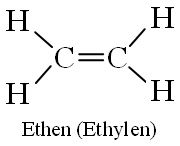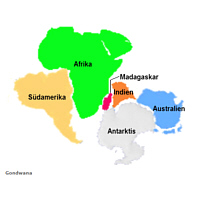Library
In my library you can find definitions of botanical terms I used on my sites.
cleistogamy
climacteric and non-climacteric fruits
 Several fruits are able to ripen after being picked. These fruits are called climacteric fruits. Though a condition is a harvest after the achievement of picking ripeness. In this case the phytohormone ethylene – a gas – causes a post-ripening of the fruit to eating ripeness. In this biochemical process ethylene acts autocatalytic. It is absorbed by the fruit. Finally it initiates an increased uptake of oxygen and an increased release of carbon dioxide as well as ethylene by the fruit. Thereby nearby fruits are also activated to ripe after. Climacteric fruits are for example apples, bananas, passion fruits and tomatoes. Non climacteric fruits are for example pineapples, cherries, lychees and citrus fruits.
Several fruits are able to ripen after being picked. These fruits are called climacteric fruits. Though a condition is a harvest after the achievement of picking ripeness. In this case the phytohormone ethylene – a gas – causes a post-ripening of the fruit to eating ripeness. In this biochemical process ethylene acts autocatalytic. It is absorbed by the fruit. Finally it initiates an increased uptake of oxygen and an increased release of carbon dioxide as well as ethylene by the fruit. Thereby nearby fruits are also activated to ripe after. Climacteric fruits are for example apples, bananas, passion fruits and tomatoes. Non climacteric fruits are for example pineapples, cherries, lychees and citrus fruits.commensalism
convergence
dioecious
epiphyte
Gondwana
In paleogeography the southern supercontinent is called Gondwana. Gondwana included South America, Africa, Madagascar, India, Australia and Antartica. 150 million years ago Gondwana broke and its fragments drifted apart caused by the plate tectonic mechanisms. Where continental plates clashed mountains were formed, such as the collision of Europe with Africa (Alps) or Asia with India (the Himalayas).
heterotrophy
internode
monotypic taxon
neophyte
peristome
protocarnivory
saprophytism
stratification
turion
USDA Plant Hardiness Zones
International the hardiness of plants can be learned from the USDA Plant Hardiness Zones. This classification derives from the US Department of Agriculture. In all 11 main zones are differentiated. The difference of temperature is between the main zones 10 °F (circa 5,56 °C). The zones 2 to 10 are additional subdivided into zone a and b.
| zone | from °C | to °C |
|---|---|---|
| 1 | below | – 45,6 °C |
| 2a | – 45,5 °C | – 42,8 °C |
| 2b | – 42,7 °C | – 40,0 °C |
| 3a | – 39,9 °C | – 37,3 °C |
| 3b | – 37,2 °C | – 34,5 °C |
| 4a | – 34,4 °C | – 31,7 °C |
| 4b | – 31,6 °C | – 28,9 °C |
| 5a | – 28,8 °C | – 26,2 °C |
| 5b | – 26,1 °C | – 23,4 °C |
| 6a | – 23,3 °C | – 20,5 °C |
| zone | from °C | to °C |
|---|---|---|
| 6b | – 20,4 °C | – 17,8 °C |
| 7a | – 17,7 °C | – 15,0 °C |
| 7b | – 14,9 °C | – 12,3 °C |
| 8a | – 12,2 °C | – 9,5 °C |
| 8b | – 9,4 °C | – 6,7 °C |
| 9a | – 6,6 °C | – 3,9 °C |
| 9b | – 3,8 °C | – 1,2 °C |
| 10a | – 1,1 °C | + 1,6 °C |
| 10b | + 1,7 °C | + 4,4 °C |
| 11 | + 4,5 °C | above |

